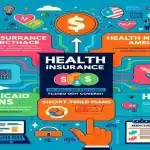
Student Loan Forgiveness Programs: A Complete Guide for 2024
Student loan forgiveness programs can help ease the burden of student debt for millions of Americans by canceling part or all of their loans. Understanding which programs are available and how to qualify can significantly impact your financial future. In this comprehensive guide, we’ll explore the different types of student loan forgiveness, eligibility criteria, and the steps you can take to benefit from these programs in 2024.
Table of Contents:
- What is Student Loan Forgiveness?
- Types of Student Loan Forgiveness Programs
- 2.1. Public Service Loan Forgiveness (PSLF)
- 2.2. Teacher Loan Forgiveness
- 2.3. Income-Driven Repayment (IDR) Forgiveness
- 2.4. State-Specific Forgiveness Programs
- Eligibility Requirements for Student Loan Forgiveness
- How to Apply for Student Loan Forgiveness
- Pros and Cons of Student Loan Forgiveness Programs
- Recent Updates in Student Loan Forgiveness (2024)
- FAQs
1. What is Student Loan Forgiveness?
Student loan forgiveness is a process that allows borrowers to have part or all of their federal student loans forgiven, or canceled, after meeting certain conditions. This can be a huge financial relief for those who work in specific fields, meet income requirements, or participate in specific repayment plans.
Forgiveness programs typically apply to federal student loans such as Direct Loans or Federal Family Education Loans (FFEL). Private student loans are generally not eligible for forgiveness.
2. Types of Student Loan Forgiveness Programs
2.1. Public Service Loan Forgiveness (PSLF)
The Public Service Loan Forgiveness (PSLF) program is designed for individuals working full-time in government or non-profit organizations. Under PSLF, after making 120 qualifying monthly payments under a qualifying repayment plan, borrowers can have their remaining loan balance forgiven. To be eligible, you must:
- Work for a qualifying public service employer (government, non-profits).
- Make payments under an income-driven repayment (IDR) plan.
- Ensure your loans are part of the Direct Loan program.
Key benefit: PSLF can provide complete loan forgiveness after 10 years of payments.
2.2. Teacher Loan Forgiveness
Teacher Loan Forgiveness is available to teachers who work in low-income schools or educational service agencies for five consecutive years. Under this program, eligible teachers may receive forgiveness of up to $17,500 on their Direct Subsidized and Unsubsidized Loans, or FFEL Loans.
Key benefit: Designed to encourage teachers to serve in high-need areas, providing relief after 5 years of service.
2.3. Income-Driven Repayment (IDR) Forgiveness
Under Income-Driven Repayment (IDR) plans, borrowers can have their remaining loan balance forgiven after 20 or 25 years of qualifying payments, depending on the plan:
- Pay As You Earn (PAYE)
- Revised Pay As You Earn (REPAYE)
- Income-Based Repayment (IBR)
- Income-Contingent Repayment (ICR)
Key benefit: IDR plans offer forgiveness to those who might not qualify for PSLF but have made payments over a long period, generally based on their income.
2.4. State-Specific Forgiveness Programs
Some states offer student loan forgiveness programs aimed at incentivizing certain professionals, such as doctors, nurses, and lawyers, to work in underserved areas. These state-run programs vary widely in their offerings and eligibility requirements.
Key benefit: Additional opportunities for student loan forgiveness based on professional location and service.
3. Eligibility Requirements for Student Loan Forgiveness
To qualify for student loan forgiveness, you must meet the program-specific criteria, which typically involve:
- Employment in specific sectors: Public service, education, or nonprofit work is common for many forgiveness programs.
- Loan type: Most forgiveness programs are available for federal loans like Direct Loans, and less frequently for FFEL and Perkins loans.
- Payment history: Consistent, timely payments under a qualifying repayment plan (like an IDR) are often required.
- Income level: Some programs, particularly income-driven repayment plans, use your income level to determine your eligibility.
4. How to Apply for Student Loan Forgiveness
Step 1: Determine Eligibility
First, research and verify whether you meet the requirements of a specific forgiveness program (e.g., PSLF or Teacher Loan Forgiveness).
Step 2: Consolidate Loans if Necessary
If you have older loans from the FFEL program, you may need to consolidate them into Direct Loans to qualify for forgiveness programs like PSLF.
Step 3: Submit Employment Certification Form (PSLF)
For PSLF, submit the Employment Certification Form annually and whenever you change employers to track your qualifying payments.
Step 4: Apply for Forgiveness
Once you meet the eligibility requirements and complete the required number of payments, submit the official forgiveness application to your loan servicer. Make sure all required documentation is submitted.
5. Pros and Cons of Student Loan Forgiveness Programs
Pros
- Significant Debt Relief: Programs like PSLF can lead to substantial savings by forgiving remaining balances after just 10 years.
- Encourages Public Service: These programs incentivize borrowers to work in public service or high-need areas.
- Flexible Repayment Plans: IDR plans adjust your payments based on income, offering relief to low-income borrowers.
Cons (H2)
- Strict Requirements: Many programs have detailed and specific eligibility criteria that must be followed closely.
- Tax Implications: Some forgiveness programs (like IDR forgiveness) may result in forgiven balances being taxed as income.
- Long Time Frames: Some forgiveness options require 20-25 years of consistent payments.
6. Recent Updates in Student Loan Forgiveness (2024)
1. Temporary PSLF Waivers
In 2021, the Department of Education introduced a temporary waiver that allows certain borrowers to count more payments toward PSLF, even if they were made under the wrong repayment plan or loan type. This waiver was extended to help more borrowers qualify in 2024.
2. Expansion of Income-Driven Repayment Plans
In 2024, the Biden administration expanded access to more affordable IDR plans, including the introduction of a new plan that lowers monthly payments and shortens the forgiveness timeline for low-balance borrowers.
7. Frequently Asked Questions (FAQ)
1. How do I know if I qualify for PSLF?
You must work full-time for a qualifying public service employer and make 120 qualifying payments under a qualifying repayment plan. Submitting the Employment Certification Form is the best way to confirm eligibility.
2. What happens if I don’t qualify for PSLF?
If you don’t qualify for PSLF, you may still be eligible for forgiveness under an IDR plan after making payments for 20-25 years.
3. Are forgiven loans taxable?
Loans forgiven under PSLF are not taxable, but loans forgiven under some IDR plans may be taxed as income unless changes are made to the tax laws.
4. Can private loans be forgiven?
No, student loan forgiveness generally applies only to federal loans. However, some private lenders may offer relief options, but these are rare.
5. What’s the quickest way to get student loan forgiveness?
The fastest path to forgiveness is through Teacher Loan Forgiveness (5 years) or Public Service Loan Forgiveness (10 years), provided you meet all requirements.
Conclusion
Understanding and taking advantage of student loan forgiveness programs can provide immense financial relief. Whether you work in public service, education, or are on an income-driven repayment plan, there’s a program for you. Take the time to research, apply, and monitor your progress toward financial freedom.
Make 2024 the year you take control of your student loans!










